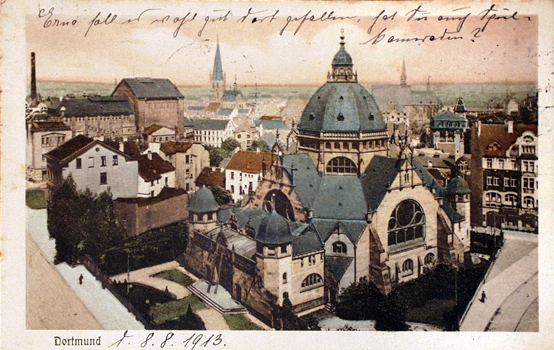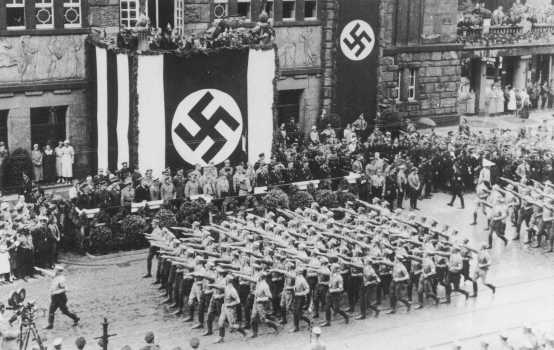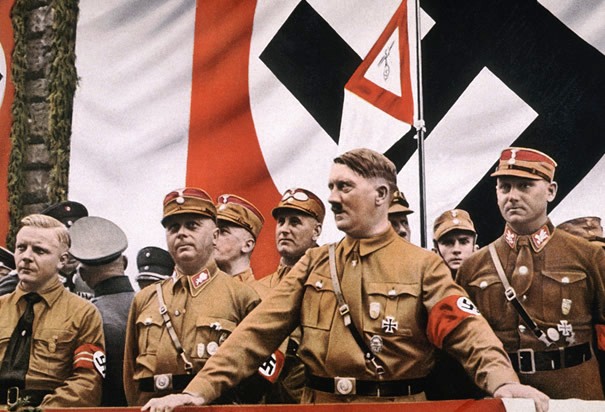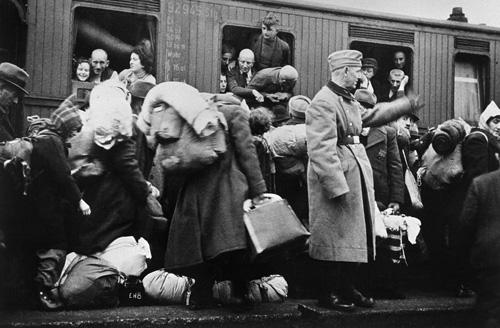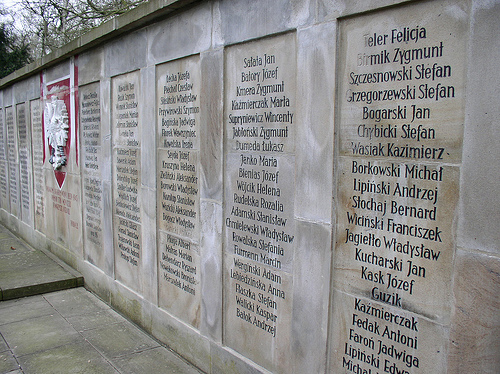Dortmund The City and the Holocaust
Dortmund a major city in Germany is located in Westphalia and records show that there were transient Jewish merchants present in the late 11th Century.
A Jewish settlement was established during the 13th Century with an organized community with a synagogue. A cemetery was opened outside the city walls in 1336 and in 1350 during the Black Death, the Jews were accused of poisoning wells, they were arrested and expelled under an agreement between the Count of the Mark and the municipality to divide up their property, some Jews did not survive this ordeal.
In 1372 the Jews were invited to return, so that the municipality might again benefit from their financial acumen, ten protected Jewish families were present by 1380 with Shimshon ben Shemuel of Dueren as their Rabbi. The Jewish population dropped with the decline of the city as a political and economic force and by the mid fifteenth century no Jews remained in the city.
Residence rights were again granted in 1543, but in 1596 the Jews were expelled, effectively signaling the end of a Jewish presence in Dortmund until the modern era.
Only after equal rights were accorded to the Jews in the Grand Duchy of Berg in 1808 were residence restrictions lifted and merchants and peddlers living in nearby villagers allowed to settle. In 1846, 38 Jewish families were living in difficult economic circumstances.
In the middle 19th Century with the accelerated economic and demographic development of the city, the situation of the Jewish community improved and its population began to expand rapidly, reaching a figure of 1,942 out of a total of 142,733 in 1900.
A synagogue was built in the mid-19th Century and a new synagogue, one of the most beautiful in Germany, with a seating capacity of 1,200 was consecrated in 1900.
A Jewish elementary school was founded in 1840 by 1871 it had over one hundred students, which increased to 220 by 1910, when it became part of the public school system. Religious classes were provided for children attending non-Jewish schools and a Talmud torah with an enrolment of 50 was opened in 1916 under Orthodox auspices.
Agudat Israel became active in 1914, the Zionist group active in 1899 was the earliest in Westphalia. In 1907, 62% of the Jewish population were engaged in trade and transport services; 23% in crafts and industry; and 5.2% belonged to the free professions. Jews took an active part in public life following emancipation, with three serving on the municipal council in 1910 and one serving as chairman of the local medical society.
In the late 19th Century Dortmund became a focus of anti-Semitic propaganda in Westphalia. The anti-Semitic Westfaelische Reform was published there from 1882, attacking Jewish merchants and inciting occasional mob violence.
In the Reichstag elections of 1890 the anti-Semites won 3% of the vote, but this anti-Semite faction all but practically disappeared by the end of the century.
Anti-Semitic outbursts were renewed after the First World War against a background of economic crisis, during the Great War many East European Jews settled in Dortmund, representing a third of the Jewish population in 1925 which had now increased to 3,820.
The established Jewish population comprised the middle class, mostly businessmen, but with some professionals, musicians, theatre people and artisans. The Jews from Eastern Europe constituted the lower class, living in slum neighborhoods and earning meager livelihoods in petty trade, peddling, and crafts.
It was they who strengthened the city’s Orthodox circles as well as the Zionist movement. Hebrew courses were offered from 1921 under Zionist auspices. The struggle for representation between the East European and German Jews created a public outcry echoed in the Jewish press throughout Germany, with the old guard accusing the Zionists of endangering the “patriotic German character” of the community.
The Jewish community maintained extensive social and welfare services, including a soup kitchen providing schoolchildren with a warm cup of milk each day and women’s organizations sending needy children to summer camps.
An orchestra and choir were active and the Jewish community published a bulletin, within the city Jews belonged to professional associations and sports and hiking clubs.
In June 1933, four months after the Nazis came to power, the Jewish population numbered 4,108 out of a total population of 540,875 The new regime undertook a Nazification campaign in the municipality, eliminating Jews and opposition forces.
During 1933, 217 Jews were arrested, including a few from other communities in the district. Many fell victim to random acts of violence and harassment by individuals.
The economic boycott against the Jews was rigorously enforced with municipal institutions breaking off commercial ties with the Jews and shoppers staying away from stores owned by Jews.
Agitation against Jewish businessmen was intensified in the summer of 1935, with boycott watches in front of Jewish stores with windows occasionally smashed. Anti-Jewish demonstrations were accompanied by signs labelling the Jews as traitors, murderers, warmongers and defilers of women.
The community strove to sustain its members, organizing cultural and educational activities. The Jewish Cultural Association offered lectures in Jewish subjects and produced plays and concerts; the community bulletin published articles on Palestine and Jewish history.
The community also offered practical vocational training and courses in Hebrew and English. In 1934 the Palestine Office opened a local branch and together with Hehalutz, organized emigration to Palestine.
Welfare services brought financial relief to 800 Jews while the Jewish school, which also offered vocational training, accommodated 356 children in 1934 and 258 in February 1938.
In July 1938, the municipality instituted proceedings to dismantle the Great Synagogue, a process which began on the 3 October 1938, more than a month before Kristallnacht, which took place on the 9th and 10th of November 1938.
By August 1938 the Jewish community was reduced to 2,600 with 500 business establishments still operating. By October the number of Jewish businesses had been reduced by a further 144 and 600 Jews with Polish citizenship were expelled from the city.
On the infamous Kristallnacht Jewish homes and stores were wrecked along with the community centre and wealthy Jews were forced to make “contributions” to their tormentors.
Immediately following Kristallnacht 600 Jews were arrested, most being sent to the Sachsenhausen concentration camp, seventeen died there and others were released after paying extortionate demands.
Another 500 Jews fled the city after the pogrom, leaving a Jewish population of 1,444 by May 1939. Just 63 houses remained in Jewish hands in September 1939 and at the end of the same year just 80 business establishments.
With another 200 Jews managing to leave after the outbreak of war, 1,222 remained in June 1941 - these were left without rights, property, homes or income. They were not allowed to use public shelters, radios, telephones, or even the streets without authorization. Gradually they were confined to “Jewish houses.”
Dortmund was used as a “concentration point” for deportations to the East, between 1942 and 1945 there were eight transports, each containing about 5,000 Jews, including the Jews of Dortmund.
On the 27 April 1942 the largest group of Jews from Dortmund numbering 700 -800 was deported to Zamosc in the Lublin district of Poland and from there sent to the Belzec death camp, which a month earlier had commenced gassing Jewish communities in the Generalgouvernment.
After the war , 40 -50 survivors mostly from the Theresienstadt ghetto, formed a new community, which grew to 420 in 1962 making it the largest in Westphalia and in the 1990’s Jews arriving from the former Soviet bloc created a Jewish community of 1,310 by 1993.
The History of the Second World War – published by Purnell London 1966 Encyclopaedia of Jewish Life Before and During the Holocaust, edited by Shumel Spector, published by New York University Press 2001 Wiener Library Chris Webb Archive Holocaust Historical Society NARA PRO Copyright Chris Webb H.E.A.R.T 2010 |
